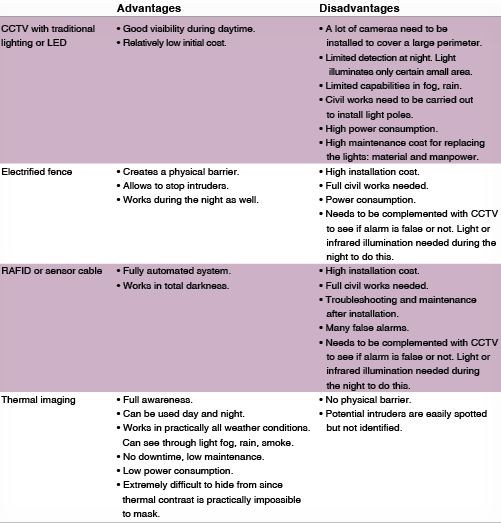

Securing an area during the daytime is one thing. But what happens during the night? And in weather conditions like fog, rain and snow? What can be detected if CCTV cameras are blinded by the sun? As CCTV systems become more advanced the security industry will move to raise the standard for all installations to be designed for 24-hour surveillance, not just daytime operation. To be truly secure, a site must be protected day and night.
A number of tools are available to help detect potential intruders in the dark. Often, different technologies are being combined to create a secure perimeter. Fences can be complemented with CCTV systems with or without active infrared illumination of old fashioned light bulbs, radio frequency intruder detection (RAFID) systems, thermal imaging cameras and/or walking patrols.
Whatever solution or technology is chosen for securing an area, they all have their advantages and disadvantages and some technologies are more expensive than others. To get a full picture of the total cost of ownership (TCO) for a certain solution, not only the initial installation cost but also the maintenance cost needs to be taken into account. Some solutions consume a lot of power and need a well-stocked supply of spare parts.
Environmental and energy consumption issues are high on the global agenda today. Given that $1 from every $5 spent globally is used on lighting, and much of this is spent on inefficient and unnecessary lighting, particular attention should be given to this area. The focus to save energy by looking at running costs will continue to increase, local authorities and private industries are all looking at methods to save energy costs and lighting is one area due careful attention. Quite a number of technologies are available to help detect potential intruders in the dark before they become a real hazard. Let us compare some of them:
CCTV combined with traditional lighting
CCTV systems have been an effective tool for security and surveillance applications. However, just like the human eye, CCTV cameras do not see too much in total darkness. In order to detect intruders at night they are often complemented with traditional lights. Although some bulbs (florescent lamps, HID lamps) are more efficient than others, the operational cost is very high. Light can only penetrate a certain distance and completely illuminating an area, so that it can be kept under surveillance of CCTV cameras, is not always possible. Powering and maintaining the lights can be even more costly.
CCTV with traditional lamp lighting requires lamp replacement every 2000 to 4000 hours or every eight months. There is significant labour and material cost associated with lamp replacement.
On the negative side, lighting essentially lays out a route of attack for intruders, creating shadows in which they can hide and access undetected.
CCTV combined with LEDs
Compared to any bulb, LEDs provide significant savings on electrical consumption. LEDs also provide long-life performance with little ongoing maintenance costs. Infrared illumination with LEDs, sometimes also called active infrared, beams infrared radiation into the area in front of the camera. The LEDs are often placed around the lens of the camera.
LED illumination is compromised by limited range performance. Also providing lighting for domes has long been a challenge for CCTV professionals as the lighting can not be fitted to move with the camera.
Electrified fences
In order to keep intruders out of certain areas fences can be constructed. To further increase security, fences can be equipped with sensors that generate an automatic alarm when someone touches the fence. Or they can be electrified to keep intruders away.
In all cases, fences need to be complemented by other technologies such as CCTV cameras or walking patrols in order to see what is happening around the fence.
Radio frequency intruder detection (RAFID)
The simplest description of RAFID is to consider a system using two specially designed cables – one transmitting a radio wave, while the other receives the wave.
Changes in the amount of signal passing between the transmitter cable and receiver cable are analysed by a signal processor. If the amount of signal changes, this means that someone or something is between the two cables and an alarm will go off. Due to the difference in the signal strength, the system can detect whether these changes are due to the presence of a human or an animal. Note that in many cases, CCTV cameras still need to be installed in order to see what is generating a real, or false, alarm.
Thermal imaging
A new tool for seeing in total darkness, in the most diverse weather conditions is thermal imaging. Thermal imaging is the use of a camera to see thermal energy emitted from an object. Thermal imaging cameras produce images of invisible infrared or heat radiation. Based on temperature differences between objects, thermal imaging produces a crisp image on which the smallest of detail can be seen. They work both during daytime and nighttime.
Deciding which technology to use
Security managers are more familiar with certain technologies than others. Before making a final decision about which technology will be implemented to secure a perimeter, it is a good idea to have a look at the advantages and disadvantages of each technology. This table tries to summarise the different technologies and their advantages and disadvantages.

Conclusion
Although all technologies have advantages and disadvantages, a small calculation makes it clear that thermal imaging is a good and a very cost effective solution for protecting a perimeter. Moreover, fewer thermal cameras need to be deployed to cover the same area. The civil works that need to be carried out are minimal. In some cases the cameras can even be mounted on existing structures.
Furthermore, since thermal imaging cameras produce a clear image in the darkest of nights, no complementary technologies like light or infrared illuminators need to be installed. Not only is this limiting the amount of civil works that needs to be carried out, but is it also reducing the maintenance cost. Thermal imaging cameras also generate fewer false alarms which is a common problem with CCTV cameras combined with video motion detection or video content analysis software.
Although thermal imaging cameras are more expensive than CCTV cameras at initial purchase, the case study shows that they are often not only the best, but also the most cost effective solution.
For more information contact Timeless technologies, +27 (0)21 914 6144, [email protected], www.timetech.co.za

© Technews Publishing (Pty) Ltd. | All Rights Reserved.